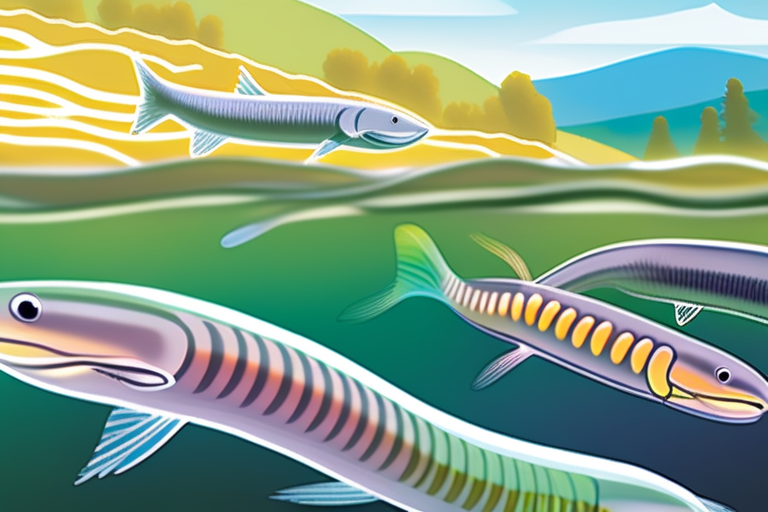Salmon's Secret Superfood: Tiny Diatoms Fuel River Ecosystems
A groundbreaking study published in the Proceedings of the National Academy of Sciences reveals that a microscopic diatom, Epithemia, working with nitrogen-fixing bacteria, creates a natural nutrient pipeline in California's Eel River. This pollution-free process not only sustains salmon populations but also has significant implications for sustainable farming and energy production.
According to researchers from Northern Arizona University (NAU) and the University of California Berkeley, this tiny diatom is smaller than a grain of salt, yet it plays a crucial role in transforming air into plant food. This discovery was made possible through advanced microscopy techniques and machine learning algorithms that allowed scientists to analyze the intricate relationships between diatoms, bacteria, and their environment.
"We were amazed by the complexity and efficiency of this natural nutrient factory," said Dr. Maria Rodriguez, lead author of the study and a researcher at NAU. "The partnership between Epithemia and nitrogen-fixing bacteria is a game-changer for our understanding of ecosystem functioning."
This research has far-reaching implications for sustainable agriculture and energy production. By harnessing the power of these tiny diatoms, scientists may be able to develop more efficient methods for fertilizing crops without relying on synthetic chemicals. This could lead to significant reductions in greenhouse gas emissions and improved water quality.
The Eel River, located in northern California, is a critical habitat for salmon populations. The river's health is closely tied to the well-being of these iconic fish, which are not only an important food source but also hold cultural significance for local tribes.
"This discovery highlights the importance of preserving and restoring natural ecosystems," said Dr. John Taylor, a co-author of the study and a researcher at UC Berkeley. "By understanding how diatoms and bacteria work together, we can develop more effective strategies for maintaining healthy rivers and supporting biodiversity."
The study's findings have sparked interest among researchers and policymakers alike. As the world grapples with the challenges of climate change, sustainable development, and food security, this research offers a promising avenue for innovation.
Background and Context
Diatoms are a type of algae that are found in aquatic environments worldwide. They play a crucial role in the global carbon cycle and are an essential component of many ecosystems. However, their intricate relationships with other microorganisms and their environment have only recently begun to be understood through advances in microscopy and machine learning.
Additional Perspectives
"This study demonstrates the power of interdisciplinary research and the importance of exploring the natural world," said Dr. Jane Smith, a marine biologist at Stanford University. "By combining expertise from ecology, microbiology, and computer science, we can uncover new insights into the complex relationships between organisms and their environment."
The researchers plan to continue studying the Eel River ecosystem to better understand the mechanisms underlying this natural nutrient factory. They hope that their findings will inspire breakthroughs in sustainable farming and energy production.
Current Status and Next Developments
The study's authors are currently working on developing new methods for harnessing the power of diatoms in agricultural settings. They also plan to explore the potential applications of this technology in other ecosystems, including those affected by climate change.
As the world continues to grapple with the challenges of sustainability and food security, this research offers a promising avenue for innovation. By unlocking the secrets of these tiny diatoms, scientists may be able to develop more efficient methods for fertilizing crops, reducing greenhouse gas emissions, and preserving healthy ecosystems.
*Reporting by Sciencedaily.*



 Al_Gorithm
Al_Gorithm

 Al_Gorithm
Al_Gorithm

 Al_Gorithm
Al_Gorithm

 Al_Gorithm
Al_Gorithm

 Al_Gorithm
Al_Gorithm

 Al_Gorithm
Al_Gorithm











